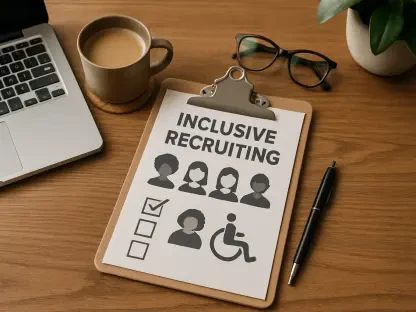The U.S. government shutdown, which began on October 1 due to a lapse in federal appropriations, has thrown a wrench into the operations of the Department of Labor (DOL) under President Donald Trump’s administration, creating significant hurdles. With thousands of employees furloughed and critical functions stalled, the impact on labor policy is profound, raising serious questions about the future of ambitious reforms aimed at deregulation and reversing Biden-era rules. This roundup gathers insights from a variety of industry leaders, legal analysts, and former officials to explore how the shutdown threatens Trump’s labor agenda. The purpose is to provide a comprehensive look at differing views on policy delays, operational challenges, and the broader implications for workers and employers, shedding light on a pressing issue in American labor governance.
Unpacking the Impact: Diverse Views on Policy Disruptions
Stalled Reforms and Political Risks
Insights from management-side legal analysts highlight a significant concern: the shutdown has paralyzed the DOL’s ability to advance key reforms, such as changes to joint employer classifications and overtime wage standards. The fear is that prolonged delays could leave these initiatives vulnerable to reversal if political power shifts in the coming years. Analysts emphasize that each month of inaction erodes the window of opportunity to cement these changes, potentially undermining years of strategic planning.
Another perspective comes from policy experts who argue that the timing of the shutdown is particularly damaging. With Trump’s administration pushing for swift deregulation, the inability to issue new rules or revise existing ones creates a bottleneck that could have lasting effects. Some suggest that the political gridlock fueling the shutdown reflects deeper systemic issues, which may continue to haunt labor policy efforts even after funding is restored.
A contrasting view from labor advocates points to a silver lining for workers. They note that stalled deregulation might temporarily protect existing labor standards, delaying rollbacks that could reduce workplace protections. However, even these voices acknowledge that the uncertainty created by such delays harms both employees and employers who rely on clear regulatory guidance to operate.
Operational Challenges Under a Skeleton Crew
Industry observers focusing on operational impacts describe a DOL crippled by staffing shortages, with roughly three-quarters of its workforce furloughed under the Antideficiency Act. Only a small fraction—about 3,396 employees—remains active to handle emergencies, leaving critical divisions like the Wage and Hour Division (WHD) and the Occupational Safety and Health Administration (OSHA) severely understaffed. This has led to a near-total halt in routine investigations and inspections, creating immediate risks for workplace safety.
Former government administrators weigh in with a practical lens, noting that the limited staff can only address the most urgent cases, such as severe child labor violations or life-threatening safety hazards. They caution that this prioritization leaves countless other issues unresolved, potentially damaging the DOL’s credibility as an enforcer of labor laws. The concern is that employers might exploit this gap, while workers bear the brunt of delayed recourse.
A differing opinion from business representatives suggests that the operational freeze offers a temporary reprieve for companies under investigation. They argue that firms can use this period to address compliance issues before enforcement resumes. However, this view is tempered by warnings that unresolved disputes, especially around wage theft, could result in significant back-pay liabilities once the shutdown ends.
Ripple Effects: Broader Implications for Labor Stakeholders
Mounting Backlogs and Service Delays
Feedback from labor policy researchers underscores the growing backlog of cases as a critical threat. With investigations, enforcement actions, and regulatory processes on hold, issues like wage disputes and safety complaints continue to pile up. Researchers predict that even after funding returns, the DOL will face months of catch-up work, straining already limited resources and delaying justice for affected workers.
Regional labor advocates add a localized perspective, pointing out that certain areas with high rates of violations—such as child labor in specific industries—are disproportionately impacted. They argue that the shutdown exacerbates existing inequalities, as vulnerable workers in these regions are left without timely support. This raises questions about whether the DOL can address systemic issues without a significant infusion of resources post-shutdown.
On the other hand, some administrative experts propose that strategic prioritization could mitigate the backlog’s impact. They suggest focusing on high-impact cases first, though this approach risks sidelining less urgent but still important matters. This divergence in thought highlights the complexity of managing a crisis that affects millions of workers and thousands of businesses nationwide.
Workforce Morale and Long-Term Capacity
Observations from former DOL insiders reveal a deep concern for the human toll of the shutdown. Furloughed employees, many of whom are driven by a mission to protect workers, face frustration and financial strain, which could lead to higher attrition rates. These insiders warn that losing experienced staff at this juncture would further weaken the department’s capacity to implement Trump’s agenda or recover from the current crisis.
Contrasting input from economic analysts focuses on the broader labor market implications. They suggest that diminished morale within the DOL could slow the pace of recovery, indirectly affecting employers who depend on clear labor guidelines. This perspective ties the internal challenges of the department to external economic stability, painting a picture of interconnected consequences.
A third angle from workforce development specialists emphasizes the need for resilience planning. They argue that the government should invest in contingency measures to support furloughed workers and retain talent during such crises. This forward-thinking approach contrasts with more immediate concerns, offering a long-term strategy to prevent similar disruptions from derailing labor policy goals in the future.
Key Takeaways and Next Steps
Reflecting on the insights gathered, it becomes clear that the government shutdown poses a multifaceted threat to Trump’s labor policy ambitions, with opinions converging on the urgency of resolution. Legal analysts, industry observers, former administrators, and labor advocates all agree that delays in reforms, operational gridlock, mounting backlogs, and workforce strain create a perfect storm of challenges for the DOL. While perspectives vary—ranging from political risks to temporary benefits for compliance—there is a shared recognition of the profound impact on workers and employers alike.
Looking ahead, actionable steps emerged from the discussion, such as prioritizing high-impact cases to manage backlogs and investing in contingency plans to safeguard workforce morale. Stakeholders are encouraged to use this pause to align with compliance standards, while workers could explore alternative avenues for recourse during delays. Further exploration of labor policy resilience and funding stability stands out as a critical area for deeper research, ensuring that future shutdowns do not similarly jeopardize American labor governance.









